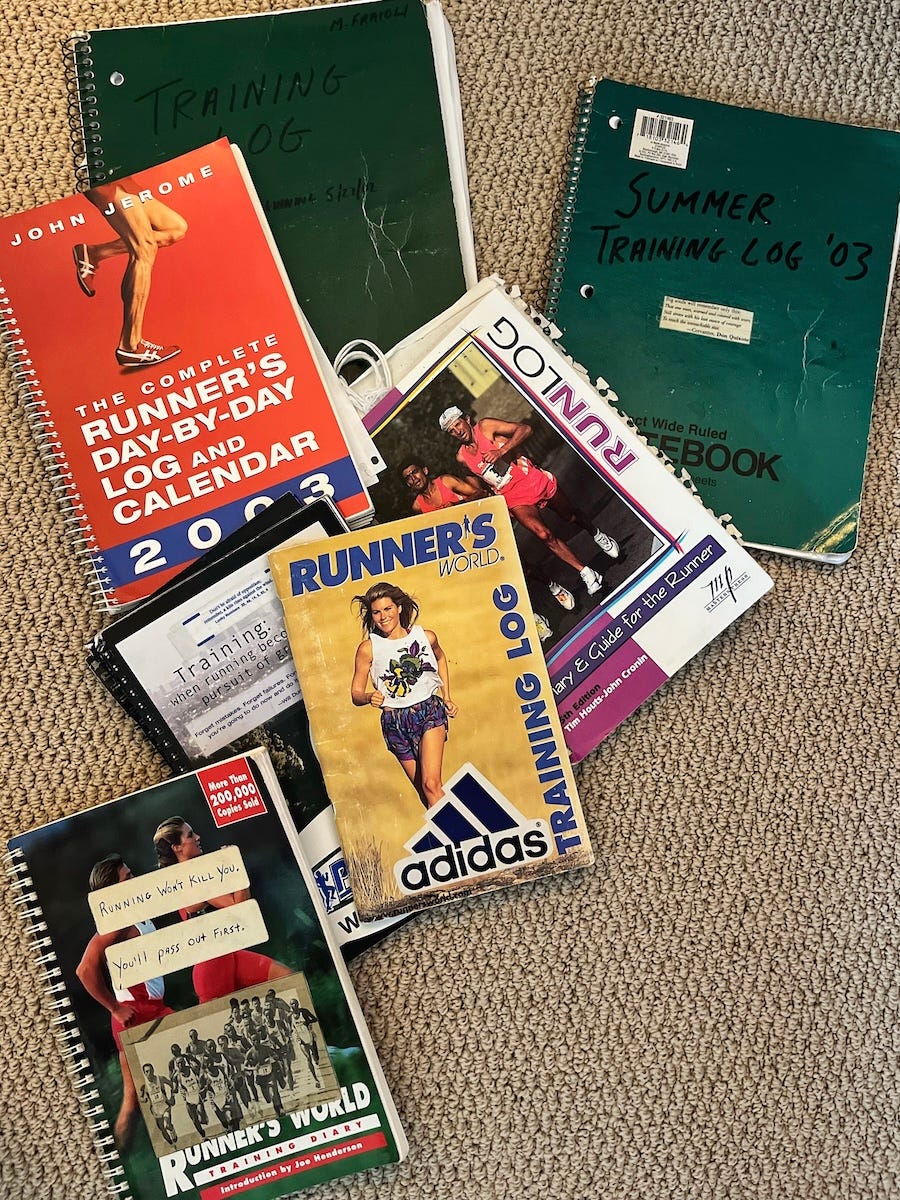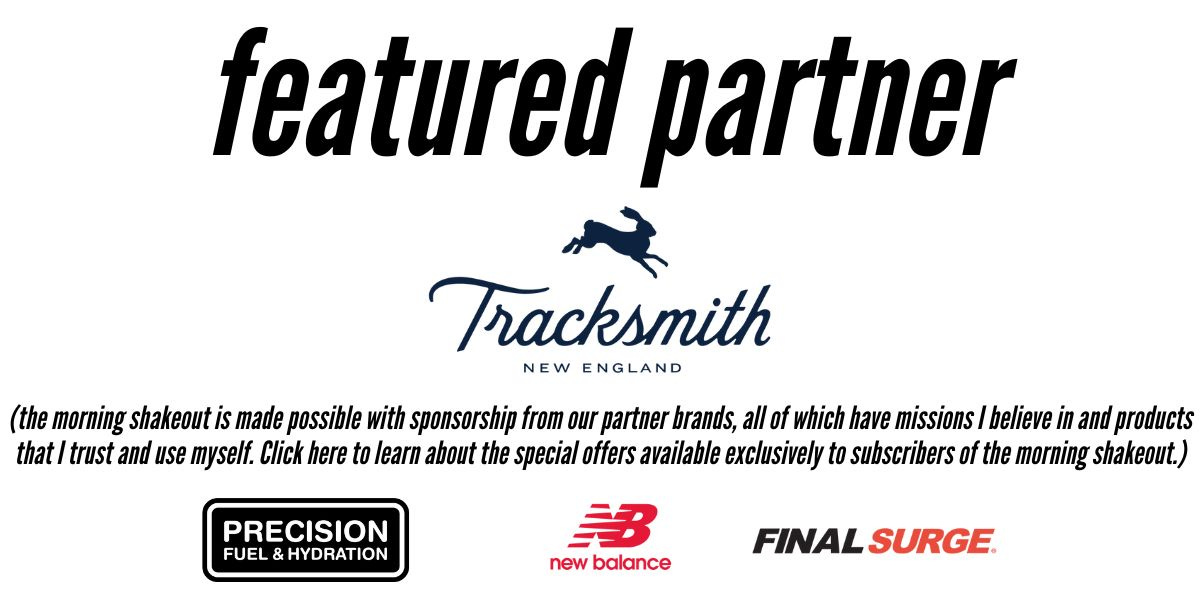the morning shakeout | issue 488
The shock of a sub-2:08, running drills you can use, learning through play, and a lot more.

Good morning! I had a couple curveballs thrown at me yesterday and my regular writing windows got smashed to smithereens. Everything is fine, just not as much time to write as I would have liked, but I did the best I could with the time I had. Let’s get right to it.
Quick Splits
— I don’t offer up much commentary on the latest running news anymore but every so often a guy like Matthew Richtman will come out of nowhere and run 2:07:56 to win the L.A. Marathon and it’s hard for me to ignore it. The unheralded Richtman, running in just his second marathon at the age of 25, took nearly three minutes off his personal best this past Sunday to run one of the top-10 fastest times ever by an American male. (n.b. I don’t believe that the L.A. course is record-eligible, however, due to its point-to-point nature.) This is, of course, awesome. I love seeing little guys break through, especially when no one really expected it. But at the same time, an American male running 2:07-high shouldn’t be a big deal in 2025. Given the number of guys in this country who can run 61 minutes and change or faster for the half-marathon in the age of super shoes, double-thresholds, and high-carb fueling, it’s still somewhat shocking to me that we don’t have more men running under 2:08 with regularity, regardless of the course. That said, Richtman’s run deserves recognition and I’m excited to follow his career from here on out. (The first time I recall seeing his name was two weeks ago while looking at the results from the U.S. half-marathon championships, where he finished sixth in 61:14.)
— In issues 485 and 486 I wrote about the performance benefits of racing over pacing, referencing Grant Fisher’s recent indoor 3000m world record run as one example of what happens when you just focus on competing rather than trying to keep up with the clock. I may have cracked a smile while reading this recent Athletics Weekly interview with Fisher, who, when asked which of his two world-record runs he preferred being a part of, responded, “I’d say the 3000m with Cole was probably more exciting and special, just because I didn’t really expect to run that fast. I expected a really good battle with him, but I didn’t think it would drag us that fast and that far under 7:30 so there was a lot of shock there. All I was focused on was racing Cole and I think he was also focused on just racing. The time completely took care of itself.”
— Last week I shared some thoughts on a recent piece by sprint coach Stu McMillan, who, aside from being one of my favorite thinkers in the sport, is also one of its greatest teachers. Yesterday I saw that he was talking about using sprinting and plyometrics to increase speed, mobility, and longevity on the latest episode of the Huberman Lab podcast, which, at three hours long, I just haven’t had a chance to listen to all the way through yet. But, I did spend 25 minutes watching him take Huberman through a sprinter’s warmup on the track and it’s valuable viewing for any coach or athlete. My biggest takeaway, which seems obvious, but is worth calling out and emphasizing here: Every little thing is done with intention.
+ Along these lines, here’s a series of short videos I put out last summer of my 10 favorite running drills to include as part of your warmup for speed workouts or races. This series of simple skips, shuffles, bounds, and other semi-explosive exercises, which are best done after a few minutes of easy jogging and before a set of faster strides, will help get the right muscles firing for the faster running to follow.
— I recently revisited this Farnam Street article, “Learning Through Play,” after going to the track with my buddy Shane, putting on our spikes, and trading off some fast-for-us 300m repeats. To borrow a concept I first came across in the novel Once a Runner, we were “playing” track, i.e., having fun with something that we’ve been doing for more than half our lives while not taking ourselves too seriously. On the last rep we dialed it up a bit and surprised ourselves with a split neither of us had seen in a while. If we had been trying to run what we did for our last rep, it probably wouldn’t have happened. But by “playing” track and pretending it was the end of a race when you don’t want to let the other guy get ahead of you down the straight, a little magic ensued. “When we play we take chances, we experiment, and we try new combinations just to see what happens,” the Farnam Street article says. “We do all of this in the pursuit of fun because it is the novelty that brings us pleasure and makes play rewarding.”
— If for nothing else, listen to Third Eye Blind’s recent set on NPR’s Tiny Desk while the audience sings along to “Jumper” to close out the set. The song, which debuted in 1997 when I was a sophomore in high school, definitely brought a wave of nostalgia along with it. But in 2025, it was hearing a few dozen people come together around the line “I would understaaaaaand” with such emotion that really got the goosebumps going.
— From the archives (Episode 197, 3 years ago this week): This conversation with Phil Shin from 2022 is one of the most meaningful and impactful exchanges I’ve ever had for the podcast—heck, it’s one of the most meaningful and impactful conversations I’ve ever had, period. It’s a solid two hours long but I promise it’s worth your while. Phil, who is now 54 years old, is a husband, a father, a Boston Marathon qualifier, and he’s still out-running cancer one mile at a time. I got to meet Phil in person for the first time just a few days after we recorded this episode and I’m proud and grateful to now call him a close friend. His story is incredible, his message is inspiring, and I’m still blown away by the circumstances that led to this conversation (and our eventual friendship). There have been many times over the past few years when I’ve wanted to quit one thing or another and every time I’ve thought, “WWPD?” The answer, which we discussed in this episode, has never steered me wrong: Keep going. (And in the spirit of friendship, now seems as good a time as any to let Phil know that he’ll be anchoring the morning shakeout’s marathon relay team a few weeks from now in Boston. No pressure buddy!)
— I’ve been using Final Surge to run my coaching business since 2017 and it’s been a game changer for both me and my athletes when it comes to planning, feedback, and day-to-day communication. Final Surge has released a few new features recently, the latest being full integration with Zwift, which allows athletes to push planned cycling and running workouts to the Zwift platform, as well as sync completed workouts from Zwift to the Final Surge calendar. You can read more about it here. (And fellow coaches: Head over to finalsurge.com and take advantage of a free 14-day coaching trial today. Use the code MORNINGSHAKEOUT when you check out to take 10% off your first purchase. Any questions? Just reply to this email and send ’em my way!)
A big thank you to Tracksmith for supporting my work in 2025. Today’s an exciting day because the Eliot Racer, a race-day shoe that combines a carbon plate with a soft yet supportive drop-in midsole, is available online worldwide (men’s sizes here, women’s sizes here). I’ve been running in it for a couple weeks now and it was good to go out of the box for a tempo run: fit like a glove with an accommodating upper for my fat forefoot, a midsole combination that provides awesome comfort and pop underfoot, and a sleek aesthetic that stands out amongst a class of shoes that often looks overbuilt. Every detail was thoughtfully considered. (The shoelaces even have this cool silicone skin on them so they won’t come undone.) I first heard about this shoe about 16 months ago and can honestly say it was worth the wait—and its spot in my rotation is secure for the foreseeable future.
Workout of the Week: The 5-n-Go Tempo
There’s a lot of confusion around the tempo run but stripped down to its core, this workout simply boils down to maintaining a steady (i.e. comfortably hard) effort for a prolonged period of time. And while the definitions of steady and prolonged can vary depending on a variety of factors, for the sake of simplicity and ease of creating a common understanding, let’s call the “classic” tempo run 5 miles at half-marathon pace. This is a pretty standard workout you’ll see utilized by a wide range of athletes and coaches to build aerobic strength, improve efficiency, and/or practice running race pace. The 5-n-Go Tempo adds a slight twist to the classic tempo run by squeezing down the pace for a mile or two at the end. Here are the details.
The bottom line.
“When men meet foes in fight, better is a stout heart than sharp sword.”
— Volsunga Saga (I got this quote from Chapter 1 of The Norwegian Method by Brad Culp, which I just started reading last week.)
That’s it for Issue 488. If you enjoyed it, please forward this email to a few friends and encourage them to subscribe at this link so that it lands in their inbox next Tuesday.
Thanks for reading,
Mario






Hi Mario,
I loved reading Grant Fisher’s words: “All I was focused on was racing Cole […] The time completely took care of itself.” That’s exactly what happened to me when I set my PBs in the 800m.
It’s strange because you’d think the opposite—that the best way to run fast is by focusing on pacing, avoiding contact, and minimizing wasted effort. But the truth is, pure competition—racing to win—is the strongest weapon to push beyond your limits. Shifting your focus from fatigue to the opponent helps you perceive the effort less, at least in my experience.
I believe that’s the magic of racing against a competitor rather than against the clock.
Completely agree with you (and Grant) on this! ✌️
Slow Motion was such a brutal song when it was released, I think the lyrics version was hard to find for awhile, so it was awesome seeing them opening with that. Motorcycle Drive By remains one of my favorite songs ever, reminds me of my whole youth. The entire album in general was the soundtrack to one of my most memorable summers ever as a kid. Crazy it's been almost 30 years.